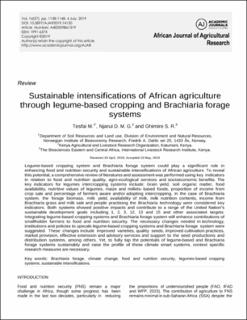| dc.description.abstract | Legume-based cropping system and Brachiaria forage system could play a significant role in enhancing food and nutrition security and sustainable intensifications of African agriculture. To reveal this potential, a comprehensive review of literatures and assessment was performed using key indicators in relation to food and nutrition quality, agro-ecological services and socioeconomic benefits. The key indicators for legumes intercropping systems include: Grain yield, soil organic matter, food availability, nutritive values of legumes, maize and millets- based foods, proportion of income from crop sale and percentage of farmers aware and/or adopting intercropping. In the case of Brachiaria system, the forage biomass, milk yield, availability of milk, milk nutrition contents, income from Brachiaria grass and milk sale and people practising the Brachiaria technology were considered key indicators. Both systems showed positive impacts and contribute to a range of the United Nation’s sustainable development goals including 1, 2, 3, 12, 13 and 15 and other associated targets. Integrating legume-based cropping systems and Brachiaria forage system will enhance contributions of smallholder farmers to food and nutrition security. The necessary changes needed in technology, institutions and policies to upscale legume-based cropping systems and Brachiaria forage system were suggested. These changes include improved varieties, quality seeds, improved cultivation practices, market provision, effective extension and advisory services and support to the seed productions and distribution systems, among others. Yet, to fully tap the potentials of legume-based and Brachiaria forage systems sustainably and raise the profile of these climate smart systems, context specific research measures are necessary. | en_US |

